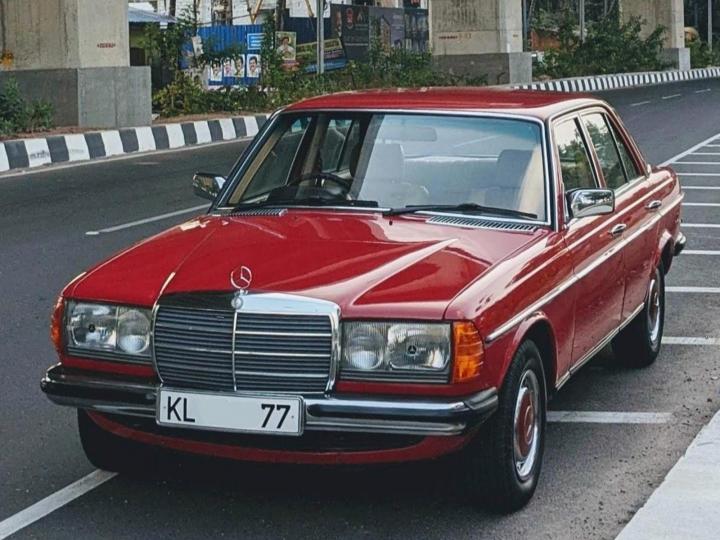News
Guide to buy a classic Mercedes Benz W123: Dos, Dont's and More
The W123 made its debut in early-1976, as a successor to the W114 generation. Mercedes officially christened it as 200-280 series, equivalent to the modern-day E-Class.
BHPian Shreyfiesta recently shared this with other enthusiasts.
Classic car buying guide : Mercedes Benz W123

Introduction :
It's a three pointed star that leads the way into happy dreams of the automotive kind. There's a used Mercedes to fit every budget, the downside is that spares and service come at a premium cost. Ageing beautifully, a W123 can be the weapon for a perfect entry into the classic car scene. Prices have been climbing over the years as well-maintained examples are getting rarer. In fact, it is the car which gave many Indians their first proper German car experience during the mid-eighties. Probably almost every cashew baron in Kerala owned one, along with a gold Rolex, more than three decades ago.
A recently restored W123 240D from Thrissur. This car was owned by ex-Kerala CM K.Karunakaran earlier.

W123s are solid purchases to make, and if you see a LHD version, the asking price does come down a considerable bit. Don't get me wrong, though the W123 generation is fairly reliable, it's not a cheap car to run. It still requires every drop of expertise from the mechanics and enough commitment from the owner. Multi-brand car workshops all over the country are familiar with its mechanicals, so you'll not have problems to keep it in good condition. After all, this is a special car that looks awesome, feels awesome and drives awesome.
BHPian Mr Perera's pristine W123 200D in a lovely shade of red.

Understanding the variants :
The W123 made its debut in early-1976, as a successor to the W114 generation. Mercedes officially christened it as 200-280 series, equivalent to the modern-day E-Class. The 123 range itself was available in various bodystyles : W123 (4-door sedan), S123 (estate), C123 (coupe) and V123 (long-wheelbase sedan). I want to stick with the W123 sedan throughout this thread because majority of the cars that came to India were sedans. A few estates too exist in our country, they are scarce however.
Pictorial representation of all bodystyles.

Speaking of the W123s in our country, diesel variants like the 200D, 240D and 300D are the most popular ones here. Petrol-engined models like the 230E and 280E are rare. While the base-model 200D diesel feels a tad underpowered, the 300D diesel is definitely a powerhouse to reckon with. A well-maintained 240D is not bad either, these are more common actually. W123s are widely available in the used car market and thankfully, most of those cars are in good shape too. Consider it your luckiest day if you find one such example.
Variant-wise engine specs of the W123.

300D, one of the most popular oldtimers out there.

Bodywork :
A lot of examples are available in the market ranging from unrestorable to just-driveable, quite a few others that have been restored. Remember, rust-proofing setups were not up to modern standards at the time when this car was produced brand new, so expect to spend a bit more in keeping its body in shape. Check the wheel arches and leading edges of the wings. One place that will rust in just about any driving environment are the undersides of the rear fenders. The shape and curve of the fenders just behind the rear wheels is such that the painted area is exposed to sandblasting from road debris kicked up by the wheels. Rear window rubbers deteriorates with age, letting the water in, resulting in rust bubbles around the rear window or the pillar trim finishers.
The rear window rust is quite common on W123, 126, etc.

Jacking points and the metal around it are common rust spots.

Rust on bottom of doors, spare wheel well, boot lid and jack points is a part of the classic Mercedes ownership. Battery tray is subject to acid leakage, slowly eating away the paint, and then begins rust cancer, a problem that means costly repairs. Keep in mind that the drainage slots directly under the hood hinges need to be kept clear. Too much water left there apparently can spill over into the floor pan. Lighter paint on some body panels may be hark back to a shunt. Stay away from such a car or bargain harder for it. Of course, the W123 can take a fair bit of beating, but it's wise not to pick up a rust box that's going extreme cheap and then spend a bomb on getting it up to shape. Mercedes will still supply original panels, but it can make a big dent in your bank account.
Check the connections on the battery for corrosion. The battery tray is known for obvious rust. Take out the battery for a better look at the tray.

This is how a partially rusted battery tray looks like.

Spare wheel well, another common rust spot.

Engines :
The two four-cylinder diesels and the single five-pot diesel seen in 200D, 240D and 300D models respectively are literally bulletproof engines that will last to half a million miles with proper periodic maintenance. Fact to be told, the 200D is terribly underpowered, but the 240D is marginally quicker. OM616 four-cylinder diesel engine on the 240D has a right balance between power and fuel efficiency. Simple yet over-engineered in typical Mercedes manner, it will run forever with regular oil changes. It is a very reliable and hardy diesel engine, the most famous weak point is the rear crankshaft seal in the form of packing, which often leaks, leading to oil starvation. Spares for this engine are easily available in India. Piston rings, timing chain, gaskets, oil filters, etc can be sourced even from shops dealing in Force Tempo Traveller spares if you are on a budget.
The famous OM616 diesel engine that did duty on W115, W123, W460 G-Class, MB100 and T1 Van.

300D's OM617 unit is an inline-five diesel engine, which got turbocharging post 1981. Common leak points are the cam cover, oil pan, and fuel-return lines. Check all of the injection system hoses, make sure that they don't leak. These are easy to replace if they do, but any leaking of fuel could point to bigger issues later. Some play in the linkage between the acceleration and the injection system is normal, but excessive play demands a closer look. The glow-plug light should stay illuminated only for less than 10 seconds. It's quite normal for diesels to smoke out, but excessive white, black, or blue smoke indicates trouble. Oil should be changed at least every 8,000 kilometers.
Neatly restored engine bay of a W123 300D diesel.

Fuel return lines on the 300D were braided line and with age they do rot and develop slow leaks. The return lines go from one injector to the next.

Transmissions :
Most of the W123s that came to India had the 5-Speed manual transmission. This particular gearbox is not really the nicest by Mercedes standards. It is notchy and agricultural for a car of this kind. Only post-1981 cars get 5-Speed box (Getrag 717.4), older cars have a 4-Speed transmission. These transmissions, however, are extremely long-lived, so any whining or signs of vagueness means the car has probably been to the moon and back, and the chances are it hasn’t been serviced properly either. Rest of the transmission is very strong, which is just as well because a rebuilt diff is big money and so is an OE clutch kit. And once again, it’s always best to stick with OE parts. The 4-Speed automatic 722.1 gearbox starts in second as a matter of course, but engages first under kickdown or when L is selected. With four gears, it should behave as a three speed except under load. Differentials are known to be solid, but always keep an eye on the driveshaft seals just to be safe.
Check the transmission mount for wear. It is up inside the cross member behind the front flex disc.

Transmission vaccum diagram for the 722.1 auto box. The VCV and transmission vacuum modulator are no longer available from Mercedes.

Suspension :
Make sure there’s no excessive play for the steering wheel because if all the adjustment has been taken up, a new steering box will be required which is an expensive affair. Over-tightened steering boxes also wear out quickly, and often the actual issue is more likely to be with the steering damper arm. The comfy ride quality sometimes hide worn shocks, and coil springs can crack or sag. Axles growl if they require immediate replacement. Rear control arms are prone to rust where the shock rests, repairing it means stripping the rear fully. A special tool is required for rear wheel bearings, this is a difficult job that requires the expertise of good mechanic, a DIY job is hence not recommended.
Check the inner and outer axle boots. Shown here is a worn out boot which is ready to split.

Steering box of a W123 with some of its parts labelled.

Brakes :
All W123s feature servo-assisted discs all round. This is a less-complicated system that shouldn’t give headaches, calipers can seize in the worst case, leading to a soft pedal and a lack of reassurance while applying brake. Master cylinders are prone to failure but replacements are neither difficult nor expensive. Apart from this it is simply a case of checking the brake fluid every two years or so, to ensure there is no water or air in the system.
Inspect the brake fluid reservoir and master cylinder for leaks. Inspect the condition of the fluid by removing the cap.

Electricals :
While many W123s didn’t feature a lot of equipment, ones that got all these options fitted seems to be reliable. Extra cost options normally includes power windows, central locking, air-conditioner, cassette player, electrically heated seats and lot more. Mercedes even offered the option for upgrading to full automatic climate control and the most expensive option available for W123 was Becker radio telephone. The central locking system is vacuum-operated, this is cool when everything works fine. When the vehicle develops a vacuum leak, you will realize it quickly as it won’t lock, or unlock correctly. Air-con can develop leaks, I'm pretty sure that many examples will still be running R12 rather than R134a. Also, make sure to operate the power antenna, or do it yourself using the switch inside the car.
The original Becker Europa 663 radio that came fitted on W123s.

Power antenna should work smoothly without excess noise. Mast should be in perfect shape too.

Vaccum locking system diagram for the W123.

Interior :
From what I've observed, there were five different options of upholstery offered for the W123 : MB Tex (the most popular one), leather, cloth, half cloth and velour. A wide variety of colour combinations were available, and finding a good condition interior to match your original is going to be difficult for sure. Tracking down matching replacement trim is virtually impossible. Check the condition of the front seat base, They’re of a special sprung design rather than relying on foam for support, but they can collapse – most notably on the outer edge of the driver’s seat base.
Picture of the original interior taken from the brochure.

The MB Tex is durable and lasts forever without much visible wear. A close up picture.

Scrapyards sometimes have seats in good shape on offer but they are rare in India, your best bet is to find a upholstery specialist who can rebuild the seat base at a reasonable price. Check for ease of movement of all air-con vents, try turning the knob to see if they open and close properly. Check the carpets and floorpans for any signs of previous water ingress. This is a sign of faulty front windscreen seal, it is a replaceable part. Note that loose interior plastic/wooden trims can be easily re-glued in most cases, while cracked or missing trim can be frightfully expensive to replace.
The aircraft-inspired air-con vents are prone to damage.

Loose interior panels can be re-glued.

Prices and availability :
In India, the W123 went towards a collectible status only in the past decade, it was known for steep depreciation at one point of time. I have seen these cars changing hands for dirt cheap prices back in the late-2000s. Some of them were sent to the scrapyard quite early when maintenance costs exceeded the resale value. 15-years old vehicle scrappage policy made things even worse for these old Mercs. However, interest for the W123 among enthusiasts have shoot up abruptly like a rocket in the recent past. As a result, used market prices also skyrocketed quickly.
A W123 featured in the movie Kaduva, to portray the rich and famous from the yesteryears.

Make no mistake, there's still a decent number of these cars around, starting out a fairly affordable price-point right now. While many examples are available ranging from rotten to just-driveable, quite a few others have been restored to showroom condition. This means that there's a used W123 in every budget. Post-1982 models are the ones to buy. The facelift in 1982 brought many upgrades to the car, including power steering as standard, improved rear leg room, a driver’s airbag and a 5-Speed manual gearbox.
Depending on the condition, let me divide the ranges into four categories :
- ₹ 1-2lakh - Neglected examples that require serious bodywork and engine overhaul at the very least. Be ready to shell out a bomb.
- ₹ 3-6lakh - Running examples in restorable shape, must be mechanically fine.
- ₹ 7-9lakh - Rust-free, well-kept examples. Beware paying loads for 300Ds, especially for ones with less than 200k kms on odo.
- ₹ 10-12lakh - The best cars, but you pay for it. Fully-restored showroom-spec examples from private collections, with service history and good interiors.
Dulquer Salman's priced possession, a 1981 W123 250 straight-six petrol.

Useful links :
- Catalog
- Data cards explained
- DIY guide
- Paint codes
- Radio specifications
- Self-leveling suspension guide
- Upholstery options
- User manual
- Vaccum diagram
- VIN decoder
- Wiring diagrams
- Workshop manual
Should you buy one?
As everyone knows, the world has moved on since ₹ 2lakh was a realistic budget for a nice W123. This shows how much the market preferences for these iconic old cars have changed. But give a classic Mercedes the love and care it needs, and you have a great sight waiting for you every morning at your car porch.
The build quality is legendary. These W123s ran for millions of kilometres as cabs in Egypt and North Africa.

Check out BHPian comments for more insights and information.















.jpg)



